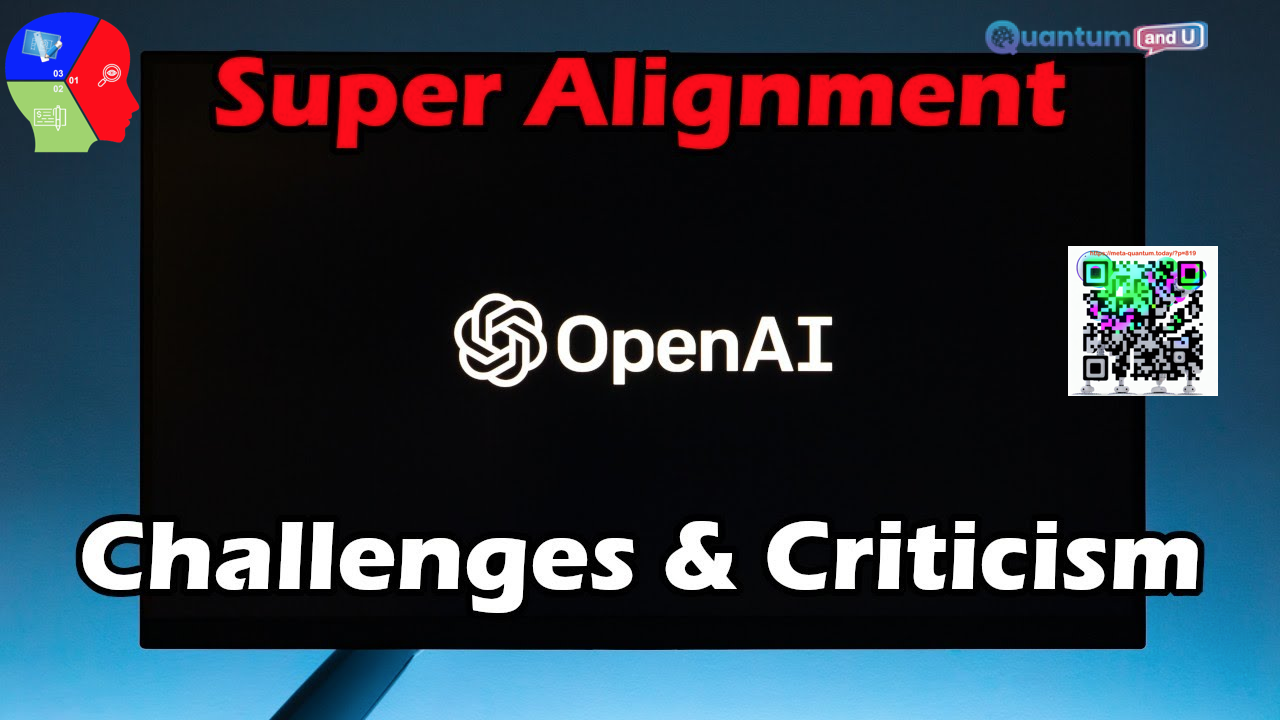
Introduction:
The YouTube video provides an insightful discussion of the concept of super alignment and OpenAI’s ongoing efforts to address AGI safety and existential risks. At its core, super alignment refers to the process of ensuring that superintelligent AI systems follow human intent and prevent catastrophic scenarios that could lead to extinction-level events. OpenAI, a leading AI research organization, has announced the formation of a super alignment team and has dedicated 20% of their computing resources to this important task.
Through the video, the creator seeks to explore various challenges and criticisms associated with super alignment, based on their understanding of OpenAI’s alignment approach. One of the primary challenges of super alignment is that human brains struggle to comprehend exponential growth, which is essential for understanding the rapid development of superintelligent AI. Additionally, the creator highlights the difficulty of generalizing AI models beyond their training distribution, along with the limitations of human perception in understanding the complexities of super intelligence.
Another major challenge of super alignment is the need to overcome cognitive biases that can influence people’s perception of AI. These biases, such as anthropomorphism, doomerism, and utopianism, can lead to denial or unrealistic expectations about AI’s capabilities and risks, which could have serious consequences.
The video also discusses various criticisms of OpenAI’s approach to super alignment. For instance, some critics argue that the competitive landscape of AI development, driven by geopolitical and military incentives, undermines OpenAI’s responsibility to ensure alignment and safety. Furthermore, some argue that OpenAI has not given enough attention to protecting human rights in its alignment research, which raises questions about its priorities and values.
Related Sections:
- Definition of Super Alignment: The creator provides a summary of OpenAI’s statement on super alignment, emphasizing its purpose to ensure superintelligent AI systems follow human intent and the need for scientific and technical breakthroughs to control these advanced systems. The focus is on preventing catastrophic scenarios and extinction-level events.
- Memes and Understanding Super Intelligence: The creator shares AI safety memes to help viewers grasp the concept of super intelligence. The memes highlight the limitations of comprehending AI models that have billions of parameters and the challenges of interpreting their behavior and decision-making processes.
- Challenges of Super Alignment: a) Normalcy Bias: Human brains struggle to comprehend exponential growth, which is essential in understanding the rapid development of superintelligent AI. The creator mentions the difficulty of generalizing AI models beyond their training distribution and the limitations of human perception. b) Understanding Super Intelligence: Even experts studying AI struggle to predict the implications and capabilities of super intelligence. The video emphasizes the complexity of foreseeing its impact on society and the future. c) Overcoming Cognitive Biases: The creator presents cognitive biases such as anthropomorphism, doomerism, and utopianism, which can influence people’s perception of AI. These biases can lead to denial or unrealistic expectations about AI’s capabilities and risks.
- Criticisms of OpenAI’s Approach: a) Geopolitical and Military Incentives: The creator discusses the competitive landscape of AI development and highlights the geopolitical and military incentives driving AI advancements. OpenAI’s responsibility is debated in terms of global arms races and maintaining influence. b) Lack of Focus on Human Rights: The video raises concerns about OpenAI’s alignment research not explicitly addressing the protection of human rights. The absence of this consideration is seen as a significant drawback and raises questions about OpenAI’s priorities and values. c) Ignoring Autonomous Agents: The creator criticizes OpenAI for not adequately addressing the development of intrinsically stable and trustworthy autonomous agents. The absence of testing and acknowledgment of this aspect is deemed alarming and raises doubts about OpenAI’s commitment to control and safety.
Conclusion:
In conclusion, the video emphasizes the importance of considering human rights in AI alignment research and highlights the significance of super alignment in mitigating risks associated with superintelligent AI. The creator expresses concern over OpenAI’s lack of focus on this topic and suggests it should be a fundamental aspect of ensuring a safe AI environment. The challenges and criticisms discussed throughout the video highlight the complexity and significance of super alignment in mitigating risks associated with superintelligent AI. It underscores the complexity of the task at hand and the need for scientific and technical breakthroughs to control these advanced systems. Ultimately, ensuring alignment with human values and protecting human rights are crucial for AI safety and the future of humanity.
Takeaway Key Points:
- Super alignment aims to ensure superintelligent AI systems follow human intent and prevent catastrophic scenarios.
- Understanding and predicting the capabilities and impact of super intelligence pose significant challenges.
- Cognitive biases, such as normalcy bias and anthropomorphism, can affect perceptions of AI.
- OpenAI’s approach is criticized for not explicitly addressing human rights and autonomous agents.
- The geopolitical landscape and military incentives contribute to the competitive development of AI.
- Ensuring alignment with human values and protecting human rights are crucial for AI safety.


